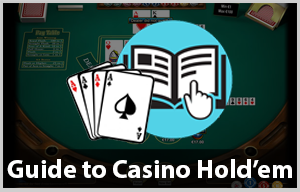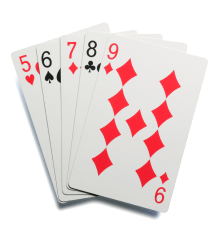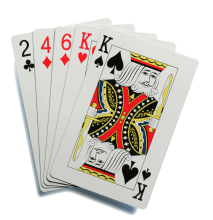
Do you love playing Texas hold‘em, but feel a tinge of guilt over taking money from your fellow civilian?
Do you enjoy hold‘em rules, but hate the psychological aspects of the game such as bluffs and tells?
Do you appreciate casino table games with relatively low house advantages?
If you answered “Yes” to any of the questions above, boy have we found the game for you. Like Texas hold‘em, Casino hold‘em is played with a 52-card deck and revolves around making hands with a combination of player cards and community cards.
The fundamental difference, however, is that in the casino version you play exclusively against the dealer rather than other players.
This game was invented in 2000 and can be found in both brick-and-mortar and online casinos. Depending on where you live and which online casinos you have access to, you may be forced to play Caribbean hold‘em instead.
But don’t worry, this is just a slight variation on the same game; we will explain the details later.
In this guide, we will cover everything you need to know before playing Casino hold‘em. We will explore how a round of Casino hold‘em is played, discuss some basic strategies to help you minimize the house advantage, and even cover basic poker terminology and hand rankings.
Once you’ve completed this guide, you will be prepared to take on any dealer and enjoy this streamlined, entertaining twist on a classic card game!
How to Play a Hand of Casino Hold‘em
Let’s look at an example of how Casino hold‘em is played. This is a step-by-step list of a single hand starting from the ante and ending when the bet is either won or lost:
- The first step in beginning a hand of this table game is to place an ante bet. This buys you into the game and will prompt the dealer to start dealing.
- After the ante, the dealer will deal 2 cards to you and 2 cards to himself or herself. The dealer’s 2 cards will be face down, while yours will not. Next, they will deal 3 community cards face up in the center of the table. These first 3 community cards are called the “flop.”
- At this point in the game, you will have some idea regarding the potential of your hand. The object of the game is to make the best 5-card hand out of the 2 hole cards (the cards dealt to you) and 5 community cards.
- Before the game proceeds any further, you have a decision to make. You may either fold and surrender the hand, losing your ante bet, or you may call and make an additional wager valued at 2 times your ante amount in order to continue.
- After you’ve decided to call, the dealer will deal 2 additional community cards. The fourth card is called the turn, and the fifth is named the river. You will now have 2 hole cards and 5 community cards with which to make the best hand.
- Lastly, the dealer will flip over their 2 cards and determine who has the strongest hand, house or player.
- The dealer must have a minimum hand of a pair of 4s in order to qualify. If they do not, the ante bet is paid out according to the payout table while the call bet will push.
- If the dealer’s hand qualifies and is stronger than yours, the house wins. You lose both your ante and call bets.
- If the dealer’s hand qualifies but is weaker than yours, you win! Your ante bet will be paid out based on the payout table, and the call bet will be paid 1:1.
Example of an Ante Bet Payout Table
Payouts will vary from casino to casino and often differ, particularly between online and land-based operations. The following table is an example of some odds that you may commonly encounter. Each value represents the amount won per each dollar staked.
| Hand |
Example 1 |
Example 2 |
Example 3 |
| Royal Flush |
20 |
25 |
100 |
| Straight Flush |
20 |
25 |
20 |
| Four of a Kind |
10 |
12 |
10 |
| Full House |
3 |
3 |
3 |
| Flush |
2 |
2 |
2 |
| Straight |
1 |
1 |
1 |
| Three of a Kind |
1 |
1 |
1 |
| Two Pair |
1 |
1 |
1 |
For example:
So, let’s say that we are playing Casino hold‘em online, where the payout table will most closely resemble Example 3. Our ante bet is $5, and we get a Four of a Kind.
We will win $50 for the ante bet, and if the hand beats the dealer’s we will earn an additional $10 for the call bet.
Possible Side Bets
Most Casino hold‘em games allow the player to make a side wager called the “AA+ Bonus” or “Pair Plus” bet. The AA+ side bet is decided after the flop.
Using the 2 player cards and 3 community cards, the player wants to make a hand consisting of a Pair of Aces or stronger. The Pair Plus bonuses are typically paid out similarly to this table:
| Hand |
Payout Odds |
| Royal Flush |
100 to 1 |
| Straight Flush |
50 to 1 |
| Four of a Kind |
40 to 1 |
| Full House |
30 to 1 |
| Flush |
20 to 1 |
| Straight |
10 to 1 |
| Three of a Kind |
8 to 1 |
| Two Pair |
7 to 1 |
| Pair of Aces |
7 to 1 |
Another side bet you may find is the progressive jackpot. This side game is based on the player’s 2 hole cards and the 5 community cards and is entirely independent of the results of the primary wager. The progressive jackpot is separate from the dealer’s hand or whether or not the player folded after the flop.
The progressive jackpot is paid out in full for royal flushes and is split if more than one player hits the jackpot. A straight flush pays the winner 10% of the total pot. The payouts for the progressive jackpot are in the payout table below:
| Hand |
Payout |
| Royal Flush |
100% Progressive Jackpot |
| Straight Flush |
10% Progressive Jackpot |
| Four of a Kind |
$500 |
| Full House |
$100 |
| Flush |
$75 |
Casino Hold‘em Strategy
Call Much More Often Than You Fold
If you follow the optimal betting strategy for this game, you will call 82% of the time while only folding 18% of hands. Playing this way results in a house edge of only 2.16%. Here are some general rules to follow when deciding whether to fold or call:
- Call any pair
- Call any open-ended straight draw
- Call any Ace-high or King-high
- Call any flush draw
- Call with 2 over-cards
- Almost always call Queen-high, unless the community cards are monotone in a different suit
- Fold when you have low unpaired cards
- Fold when the board is paired, but your cards don’t match the suit
Remember, when you call you must stake a second bet worth 2 times your initial ante wager. Since a good player is going to call 4 out of 5 hands, that means the majority of your bets will require 3 times the ante in total, 1 for the ante and 2 for the call.
These wagers can add up quickly and put a significant dent in your bankroll if you aren’t cautious. For that reason, your best bet is to keep your ante relatively low so that you don’t price yourself out of the ability to call later on.
While the rewards for hitting a side bet may look tempting, the Pair Plus gamble is nothing more than a trap. In fact, it moves the house advantage for Casino hold‘em from 2.16% all the way to 6.26–6.40%.
Merely participating in the side bets makes the house advantage 3 times as high! Dreaming about the ultra-rare Royal Flush isn’t worth swinging the math that far into the house’s favor.
Caribbean Hold‘em
Depending on which online casino you will be using, Casino hold‘em may not be an available option. If your casino site does not offer this game, they most likely provide a very similar alternative called Caribbean hold‘em.
The two games are the same in every way except for how the ante bets pay out when the dealer’s hand does not qualify.
When the dealer doesn’t qualify in Casino hold‘em, the ante bet is paid out based on the predetermined payout table, which can be quite valuable, based on the hand. The Caribbean version only pays out 1:1 for the ante, which is much less advantageous for the player.
Basic Poker Hands
A Royal Flush is the best hand in poker. It consists of an Ace, King, Queen, Jack, and Ten all of the same suit.
Example:
The second-best hand in poker is the Straight Flush. This is 5 cards of the same suit in numerical order.
Example:
The third best hand in poker is the Four of a Kind. As the name suggests, this is when you have 4 cards of the same value or rank. The fifth card is called the “kicker,” and if 2 players have matching Four of a Kinds, the highest ranked kicker breaks the tie.
Example:
A Full House is when you have 3 cards of the same value combined with 2 cards of a different matching value. So, you have a 3 of a kind and a pair in the same hand.
Example:
A Flush is when all 5 cards in your hand have the same suit. They do not need to be in any numerical order, just the same suit.
Example:
A Straight is 5 cards in numerical order, or in sequence of their value. The suit does not matter in this situation.
Example:
A Three of a Kind occurs when you have 3 cards of the same value or rank in a hand, with 2 cards that are unrelated.
Example:
Two Pair is a poker hand where you have 2 separate pairs of cards of matching value or rank and a fifth card that is unrelated.
Example:
A Pair is one of the weaker hands in poker. It’s when you have 2 cards of a matching value or rank and 3 side cards. The higher the rank of the matching cards, the better the Pair.
Example:
If a hand does not have any matching pairs, suits, or numerical sequences, its value comes down to the highest card. If neither player has anything, the highest card wins.
Common Poker Terms
Ante:
The ante is a bet made up front to seed the pot prior to a poker hand. In Casino hold‘em it is your initial bet that prompts the dealer to deal.
Board:
The board is the combination of all the community cards. You might say, for example, “There were no Kings on the board.”
Call:
Putting additional money into the pot in order to stay in the game. In Casino hold‘em, this amount is twice the value of the ante. In other types of poker, a call will match the amount of money as the most recent raise or bet.
Community Cards:
The community cards are the cards in the middle of the table, laid face up, that all players share and use to make the best hands available in combination with their hole cards.
Dealer:
The casino employee or computer program that accepts bets, deals the cards, pays out winnings, and keeps the table game progressing.
Draw:
Playing a hand that is not good on its own but has the potential to be good with the right community cards.
Favorite:
A poker hand that is statistically the most likely to win.
Flop:
The initial 3 community cards dealt. These are face up in the middle of the table. After the flop, the player has the option to fold or call based on the potential of their hole cards and the flop.
Fold:
To fold is to forfeit the hand. If a hand has a very low statistical probability of winning, it’s better to fold and cut your losses than risk additional money by calling or raising.
Hole Cards:
Hole cards are the 2 cards dealt to the player whom then uses them to make hands in combination with the community cards.
House:
The house is the casino or online betting site taking bets and offering the game.
Kicker:
A kicker is an unpaired card in a hand that is used as a tie-breaker. For example, if two players have matching Four of a Kinds, but one player’s fifth card is a King while the other’s is a Jack, the hand with the King kicker will win.
Off-Suit:
When a player’s 2 hole cards are of different suits.
Pocket:
Cards that are only able to be seen by the player to which they were dealt.
Pocket Pair:
When a player’s 2 hole cards are the same value or rank, giving them a Pair.
Quads:
Another way of saying Four of a Kind.
Raise:
Increasing the amount of the bet.
Rank:
A card’s numerical value.
River:
The river is the fifth community card dealt. This is the last card, and it is dealt face up like the rest of the community cards.
Set:
A Three of a Kind in which you have 2 of the cards in your hand with the third on the board as a community card.
Suited:
When the 2 hole cards a player is dealt are the same suit.
Trips:
Another way of saying Three of a Kind.
Turn:
The turn is the fourth community card that is dealt.
For more poker terminology, you can check out our poker glossary page, where we provide definitions and explanations of commonly used poker terms and phrases:
Final Thoughts
As you can see, Casino hold‘em is the perfect casino table game for poker fans! While it retains the majority of the rules and strategies of Texas hold‘em, it also allows the player to compete against the house in the form of a dealer rather than other players.
This makes for a much faster, streamlined game with good odds and a low house advantage.
One exciting aspect of Casino hold‘em is just how infrequently you should fold when playing the optimal strategy.
Because the dealer’s hand must qualify, staying in the game 82% of the time is the smart way to maximize your probability of winning long term. This holds true for almost any hand that you are dealt, with few exceptions.
In addition to the primary game, there are also side bets available. These can take the form of progressive jackpots, or more commonly, the AA+/Pair Plus bets. The payouts for a winning side bet are much higher than the regular game, but it is not advised to attempt to win them.
The reason these bets are frowned upon is that they increase the house advantage by 3 times!
Casino hold‘em can be found in both online and land-based casinos. Regardless of where you plan to play, it is advised that you locate an online version so that you may practice and gain a familiarity with the game before wagering real money.
Between reading this guide and practicing, whenever you are ready to begin putting real money at stake, you will have a solid foundation and decent understanding of the odds and strategies to make your time gambling a success.










